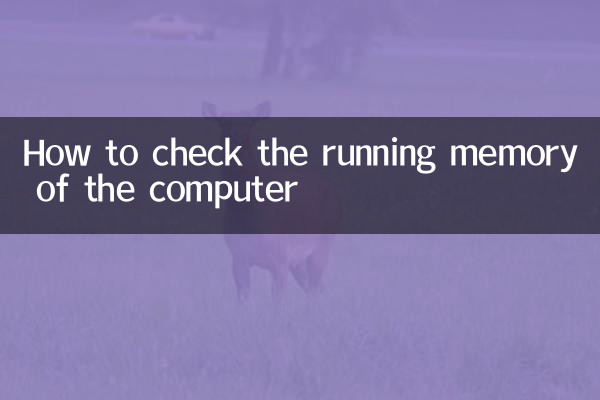How to check the running memory of the computer
In today's digital age, a computer's running memory (RAM) is one of the key factors affecting its performance. Whether it is daily office work, gaming and entertainment, or professional design, it is very important to understand the running memory of your computer. This article will introduce in detail how to check running memory in Windows and macOS systems, and combine it with hot topics in the past 10 days to help readers better manage computer performance.
1. Why should we check the running memory?

Running memory is the space where the computer temporarily stores data, which directly affects the smoothness of multitasking. If there is insufficient memory, the computer may experience problems such as lagging and program crashes. The following are memory-related discussions in recent hot topics:
| hot topics | Related content |
|---|---|
| The game "Phantom Parlu" is a hit | Players reported that the game takes up too much memory, causing lags |
| Windows 11 24H2 update | The new system optimizes memory management and improves multi-tasking performance |
| Popularity of AI tools | Running large AI models requires large memory support |
2. How to check running memory in Windows system
Here are a few common ways for Windows users to view running memory:
| method | Operation steps |
|---|---|
| task manager | 1. Right-click on the taskbar 2. Select "Task Manager" 3. Switch to the Performance tab 4. View the Memory section |
| System information | 1. Press Win+R keys 2. Enter "msinfo32" and press Enter 3. Find "Installed Physical Memory" in "System Summary" |
| command prompt | 1. Open command prompt 2. Enter “wmic memorychip get capacity” 3. Press Enter to display the memory size (in bytes) |
3. How to check the running memory of macOS system
Mac users can check running memory in the following ways:
| method | Operation steps |
|---|---|
| About this machine | 1. Click the Apple icon in the upper left corner 2. Select "About This Mac" 3. View memory information in "Overview" |
| activity monitor | 1. Open Applications > Utilities 2. Start Activity Monitor 3. Switch to the "Memory" tab |
| Terminal commands | 1. Open the terminal 2. Enter "system_profiler SPHardwareDataType" 3. Find information related to "Memory" |
4. How to optimize running memory?
According to recent hot discussions on technology forums, the following are suggestions for improving memory efficiency:
1.Close unnecessary background programs: Many applications will run in the background by default, occupying valuable memory resources.
2.Increase virtual memory: Although slower, it can temporarily alleviate out-of-memory issues.
3.Upgrade physical memory: If the motherboard supports it, adding memory modules is the most direct solution.
4.Use memory optimization tools: Some lightweight tools can help automatically release idle memory.
5. Recent Development Trends in Memory Technology
According to technology media reports, memory technology is undergoing important changes:
| technology trends | Influence |
|---|---|
| Popularity of DDR5 memory | New generation memory standard, speed increased by more than 50% |
| LPDDR5X mobile memory | Bringing enhanced performance to thin and light laptops and mobile devices |
| CAMM memory module | New form of notebook memory, supporting higher capacity |
Knowing how to check the running memory can not only help users understand the performance of the computer, but also provide a basis for upgrade decisions. In a world where applications are increasingly demanding memory, this skill is valuable to every computer user. If you find that your memory is often under high load, you may need to consider optimizing your system or upgrading your hardware.

check the details

check the details